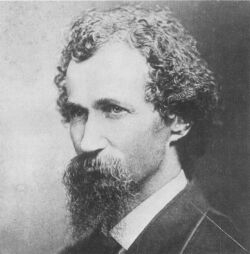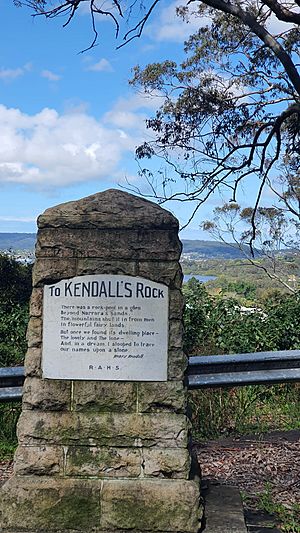Henry Kendall (poet) facts for kids
Thomas Henry Kendall (born April 18, 1839 – died August 1, 1882) was a famous Australian writer and bush poet. He was especially known for his poems and stories about nature. He usually went by the name "Henry Kendall" and published all his poetry books under that name.
Contents
Henry Kendall's Early Life
Henry Kendall was born in a small hut near Yackungarrah Creek in Yatte Yattah, close to Ulladulla, New South Wales. He was a twin, born with his brother Basil Edward Kendall. His parents were Basil Kendall and Matilda Kendall. His grandfather, Reverend Thomas Kendall, was an Englishman who came to Australia in 1809. He worked as a missionary in New Zealand before settling in New South Wales in 1827.
Kendall is also sometimes known as Henry Clarence Kendall. This might be because his family moved to the Clarence River area when he was five years old. A journalist named A. G. Stephens tried to clear up this confusion in 1928. He showed proof that the poet was christened Thomas Henry Kendall. However, he used the name Henry Clarence Kendall when he got married.
Henry Kendall did not get much formal schooling. When he was 15, he went to sea with one of his uncles. They went on a whaling trip, and he was away for about two years.
Henry Kendall's Adult Life and Career
When Henry Kendall returned to Sydney at 17, his mother was running a boarding school. He needed to find a job, so he became a shop assistant. He had already started writing poems. This led him to meet two well-known poets of that time: Joseph Sheridan Moore and James Lionel Michael. Michael, who was a lawyer, hired Kendall to work in his office. He also let Kendall use his large library. Michael later moved to Grafton in 1861. Kendall worked for him again for about six months the next year.
Kendall also became friends with Henry Parkes, who was editing a newspaper called The Empire. Parkes published some of Kendall's early poems. In 1862, Kendall sent some poems to the London Athenaeum, a famous magazine. They printed three of his poems and praised his work. In the same year, his first book, Poems and Songs, was published in Sydney. It was very popular, and all 500 copies were sold.
Because of his growing fame, Kendall was offered a job in the government's lands department in 1863. He moved to the colonial secretary's department in 1864. He was a dedicated worker. His hours were not long, which gave him time for writing. His salary increased, allowing him to provide a home for his mother and sisters.
In 1868, Henry Kendall married Charlotte Rutter. She was the daughter of a Sydney doctor. The next year, he left his government job and moved to Melbourne. At that time, Melbourne was a bigger city than Sydney and a more important place for writers. Kendall's decision to leave his job seemed risky. He had faced difficulties with money before his marriage. Also, his wife found it hard to live with his mother. Kendall felt that moving to a new city was their best chance for happiness.
In Melbourne, other writers like George Gordon McCrae, Marcus Clarke, and Adam Lindsay Gordon welcomed him. Kendall and Clarke worked together on a short-lived magazine called Humbug (1869-70). However, Kendall was not good at journalism. Some of his work was published in newspapers. George Robertson published his second poetry book, Leaves from Australian Forests, soon after he arrived. This book included 'Bell-Birds', which is one of Australia's most famous poems. Reviews were positive, but not many copies were sold, and the publisher lost money.
Kendall found it hard to earn a living only from writing. He got a temporary job in a government office that dealt with statistics. Kendall, however, was not good with numbers. He tried his best but found the work very difficult. He became very discouraged during his two years in Melbourne. He had many friends, but they could not always help him. In December 1870, he was found not guilty of a charge related to a cheque. He was unable to support his family and had to return to Sydney. He faced poor health and difficult times. He would try hard to write, but sometimes he would feel very sad. His wife had to return to her mother.
In November 1873, the Fagan brothers, who were timber merchants near Gosford, helped Kendall. He was given a job in the business of one of the brothers, Michael Fagan, at Camden Haven. He stayed there for six years and regained his confidence. In October 1880, he wrote to George Gordon McCrae, saying that Michael Fagan was "the man who led me out of Gethsemane and set me in the sunshine."
In 1880, he published his third book, Songs from the Mountains. It was a great success and helped rebuild his reputation. The book included a poem that made fun of a politician. This poem caused the book to be removed from sale because of a threat of a lawsuit. The first edition is now very rare. The book was reissued with a different poem instead.
Henry Kendall's Final Years
In 1881, his old friend Sir Henry Parkes helped him get a job as an inspector of state forests. He earned a good salary of £500 a year. However, his health was never strong. The job required long rides in all kinds of weather, which made him sick. He caught a severe cold and developed a lung illness. He died in Redfern, Sydney, on August 1, 1882. He was buried in Waverley Cemetery. His wife lived for more than 40 years after him. For the last sixteen years of her life, she received a special pension for writers' families.
Henry Kendall's Legacy
A painting of Henry Kendall, made after his death by Tom Roberts, is kept at the National Library of Australia in Canberra. In 1938, his son, Frederick C. Kendall, published a book called Henry Kendall, His Later Years. This book aimed to correct some information from another book about his father.
In 1886, a special memorial edition of his poems was published in Melbourne. In 2021, some of his poems were translated into German.
In Kendall, there is a stone sculpture dedicated to the poet on Comboyne Street (31°37′58″S 152°42′23″E / 31.632715°S 152.706367°E).
Several places are named after him:
- The small village of Kendall on the Mid North Coast of New South Wales.
- A street in Elwood, Victoria.
- Streets in Campbelltown, Padstow Heights, and Heathcote in New South Wales.
- A street and a park in Tarrawanna near Wollongong, NSW.
Henry Kendall and the NSW Central Coast
On the New South Wales Central Coast, several places honor Henry Kendall:
- Henry Kendall Street in West Gosford is home to a stone building. This building is now a museum called 'Henry Kendall Cottage'. He lived there for some time with the Fagan family.
- A retirement village in the nearby suburb of Wyoming is also named after him: Henry Kendall Gardens.
- Henry Kendall High School is also in West Gosford.
- The Henry Kendall Poetry Award is given every two years by Central Coast Poets Inc. Poets like Louise Oxley, Judy Johnson, and Joan Kerr have won this award.
On a hillside above West Gosford, near "Lookout – West Gosford," there is a stone monument. It is located on a sharp bend of the Central Coast Highway and was built before 1920. A marble plaque on the monument has a poem inscribed on it:
TO KENDALL'S ROCK
There was a rock-pool in a glen
Beyond Narrara's sands;
The mountains shut it in from men
In flowerful fairy lands.
But once we found its dwelling place—
The lovely and the lone—
And, in a dream, I stopped to trace
Our names upon a stone.
- Henry Kendall
- R.A.H.S.




